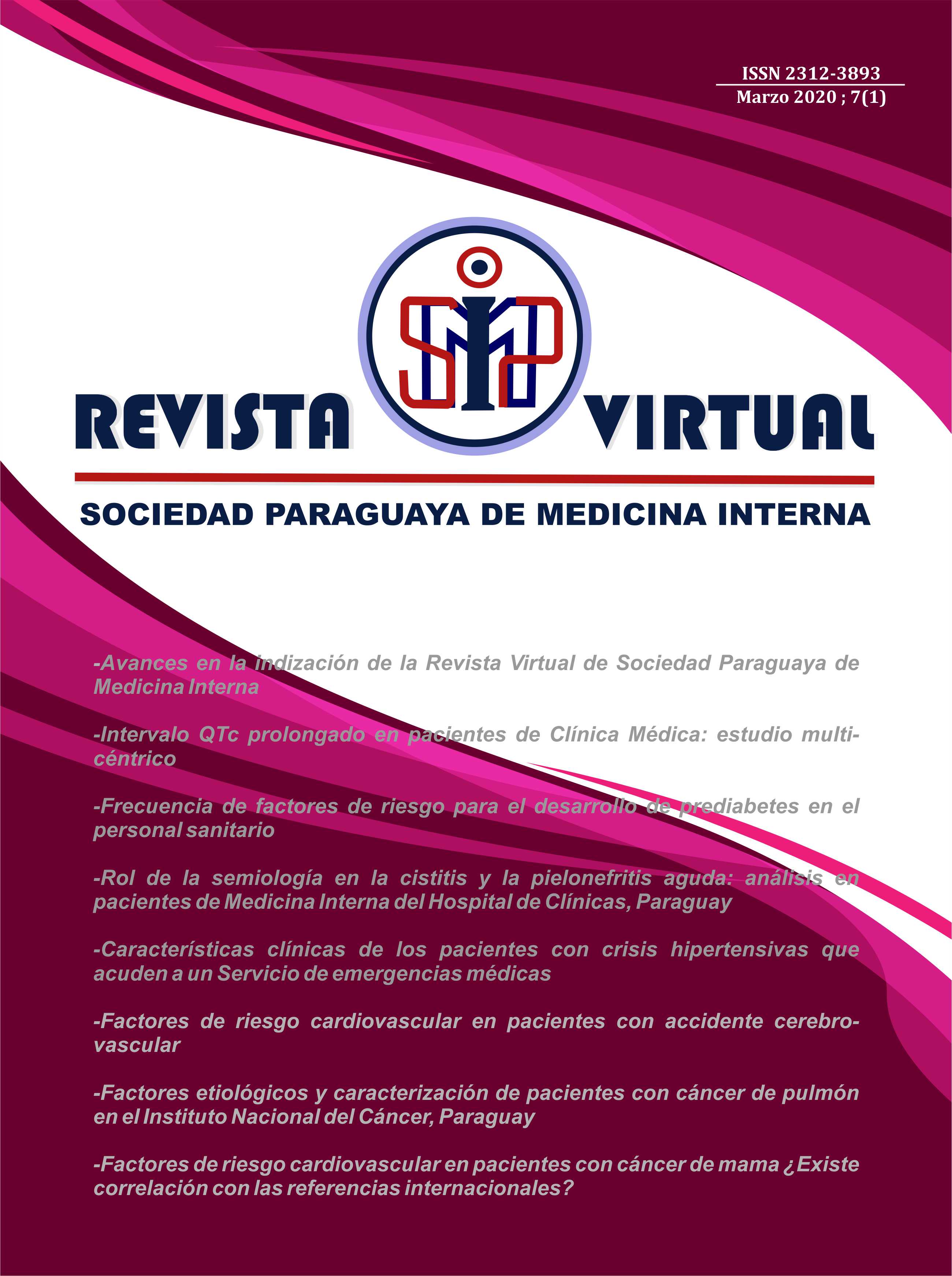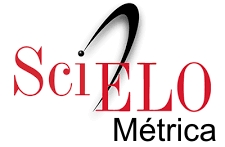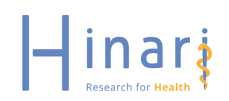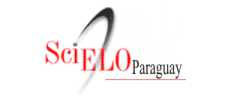Factores etiológicos y caracterización de pacientes con cáncer de pulmón en el Instituto Nacional del Cáncer, Paraguay
Resumen
Introducción: el cáncer de pulmón es un problema de Salud Pública en el mundo y en nuestro país por su alta mortalidad e incidencia. Los carcinógenos medioambientales y el tabaquismo están directamente relacionados como factores de riesgo.
Objetivo: Caracterizar los factores etiológicos de fumador activo y carcinógenos medioambientales de los pacientes con cáncer de pulmón detectados durante 9 años en el Instituto Nacional del Cáncer, Paraguay.
Metodología: estudio observacional retrospectivo descriptivo analítico de una base de datos del período 2004-2013. Las variables medidas fueron datos demográficos, carga tabáquica, tabaquismo, la exposición a carcinógenos medioambientales categoría I.
Resultados: se incluyeron 478 pacientes con cáncer pulmonar, 88,1% de sexo masculino y 11,9% femenino. La edad promedio del sexo masculino fue 60±10 años y del sexo femenino 58±12 años. La prevalencia de exposición carcinógenos medioambientales categoría I fue 36,90%. La media del índice tabáquico fue 4,48±20. El modelo de regresión lineal múltiple entre exposición ambiental, tabaquismo y tipo histológico para predecir la severidad clínica fue 3,6%. En el análisis de regresión logística de la relación de tipos histológicos con tabaquismo, género y exposición ambiental no mejoran el modelo de predicción.
Conclusiones: Los factores etiológicos relacionados con carcinógenos medioambientales estuvieron presentes en más de un tercio de la población, el hábito tabáquico es mayor en hombres que en mujeres. El tipo histológico más frecuente para ambos sexos, con y sin el hábito tabáquico, es el carcinoma de células no pequeñas.
Citas
Bray F, Ferlay J, Soerjomataram I, Siegel RL, Torre LA, Jemal A. Global cancer statistics 2018: GLOBOCAN estimates of incidence and mortality worldwide for 36 cancers in 185 countries. CA Cancer J Clin /Internet/. 2018 /cited 2019 Aug 12/; 68:394-424. Available from: http://doi.wiley.com/10.3322/caac.21492
Forouzanfar MH, Afshin A, Alexander LT, Anderson HR, Bhutta ZA, Biryukov S, et al. Global, regional, and national comparative risk assessment of 79 behavioural, environmental and occupational, and metabolic risks or clusters of risks, 1990-2015: a systematic analysis for the Global Burden of Disease Study 2015. Lancet. 2016; 388 (10053):1659-724.
Suarez-Torres JD, Alzate JP, Orjuela-Ramirez ME. The NTP Report on Carcinogens: A valuable resource for public health, a challenge for regulatory science. J Appl Toxicol. 2019 Aug 29.
Plummer M, de Martel C, Vignat J, Ferlay J, Bray F, Franceschi S. Global burden of cancers attributable to infections in 2012: a synthetic analysis. Lancet Glob Health. 2016; 4(9): e609-16.
Stewart BW, Wild ChP, edited. World cancer report 2014 /Internet/. Lyon: International Agency for Research on Cancer; 2014 /cited 2019 Jun 9/. Available from en: https://www.drugsandalcohol.ie/28525/1/World%20Cancer%20Report.pdf
Salas C, Coordinadora. Recomendaciones del club de patología pulmonar de la SEAP. En: Libro blanco de la anatomía patológica en España [Internet]. España: Sociedad Española de Anatomía Patológica ; 2015. p. 433-456. [citado 12 Sep 2019]. Disponible en: https://www.seap.es/c/document_library/get_file?uuid=649707ea-32d8-4416-994e-ce3bdc94a910&groupId=10157
Ettinger DS, Borghaei H, Akerley W, Chang A. NCCN clinical practice guidelines in oncology: Nonsmall cell lung cancer. Versión 3.2012. J Natl Compr Canc Netw /Internet/. 2012 /cited 2019 Jun 4/; 10(10): 1236-71. Available from: https://jnccn.org/view/journals/jnccn/10/10/article-p1236.xml
Pao W, Girard N. New driver mutations in non-small-cell lung cancer. Lancet Oncol. 2011; 12 (2): 175-80.
Schottenfeld D. The etiology and epidemiology of lung cancer. In: Pass HI, Carbone DP, Johnson DH, Minna JD, Scagliotti GV, Turrisi AT, editors. Principles and Practice of Lung Cancer. 4th ed. Philadelphia, Pa: Lippincott Williams & Wilkins; 2010.p.3–22.
El Zoghbi M, Salameh P, Stücker I, Paris C, Pairon JC, Gislard A, et al. Phenotypes of lung cancer and statistical interactions between tobacco smoking and occupational exposure to asbestos and crystalline silica from a large case-only study: The CaProMat study. Lung Cancer. 2017; 112:140–55.
American Cancer Society. Cancer prevention & early detection facts & figures 2015-2016 /Internet/. Atlanta: American Cancer Society; 2015 /cited 2019 Sep 2/. Available from: file:///C:/Users/Acer/Downloads/cancer-prevention-and-early-detection-facts-and-figures-2015-2016.pdf
American Cancer Society. Cancer facts & figures 2018 /Internet/. Atlanta: American Cancer Society; 2018 /cited 2019 Sep 2/. Available from: https://www.cancer.org/content/dam/cancer-org/research/cancer-facts-and-statistics/annual-cancer-facts-and-figures/2018/cancer-facts-and-figures-2018.pdf
International Agency for Research on Cancer, WHO. IARC monographs on the identification of carcinogenic hazards to humans: Preamble [Internet]. Lyon, France: WHO; 2019 [cited 2019 Aug 5]. Available from: https://monographs.iarc.fr/wp-content/uploads/2019/07/Preamble-2019.pdf
Ettinger DS, Wood DE, Akerley W, Bazhenova LA, Borghaei H, Camidge DR, et al. NCCN guidelines insights: Non-small cell lung cancer, Version 4.2016 . J Natl Compr Canc Netw /Internet/. 2016 /cited 2019 Jun 4/; 14(3): 255-64. Available from: https://jnccn.org/view/journals/jnccn/14/3/article-p255.xml
Sierra MS, Abriata MG, Barrios E, Bravo LE, Cueva P, Fernandez L, et al. Editors on behalf of the Cancer in Central and South America Working Group. Cancer in Central and South America. Lyon: International Agency for Research on Cancer; 2016.
Macias G, Barletta P, Breit D, Limardo L, Abriata G. RITA registro institucional de tumores de Argentina. Presentación, avances y resultados periodo 2012-201 /Internet/. 2nd ed. Buenos Aires: Instituto Nacional del Cáncer; 2017. /citado 7 Jul 2019/. Disponible en: http://www.msal.gob.ar/images/stories/bes/graficos/0000000955cnt-2017-04-21-presentacion-avances-y-resultador-periodo-2012-15.pdf
Codas M, Pesch B, Adolphs M, Madrazo C, Matthias C, Heinze E, et al. Cancer mortality in Itapúa -- A rural province of Paraguay 2003–2012. Cancer Epidemiol. 2016; 40:1–6.
Amos CI, Pinney SM, Li Y, Kupert E, Lee J, de Andrade MA, et al. A susceptibility locus on chromosome 6q greatly increases lung cancer risk among light and never smokers. Cancer Res. 2010; 70(6):2359–67.
Samet JM, Chiu WA, Cogliano V, Jinot J, Kriebel D, Lunn RM, et al. The IARC Monographs: Updated procedures for modern and transparent evidence synthesis in cancer hazard identification. J Natl Cancer Inst. 2019 Sep 9. pii: djz169.
Smith RA, Andrews KS, Brooks D, Fedewa SA, Manassaram-Baptiste D, Saslow D, et al. Cancer screening in the United States, 2018: A review of current American Cancer Society guidelines and current issues in cancer screening. CA Cancer J Clin. 2018 Jul;68(4):297-316.
Steinmaus CM, Ferreccio C, Romo JA, Yuan Y, Cortes S, Marshall G, et al. Drinking water arsenic in northern Chile: high cancer risks 40 years after exposure cessation. Cancer Epidemiol Biomarkers Prev. 2013; 22(4): 623–30.
Casella J, Guajardo R, Ruiz M. Epidemiologia sobre cáncer de Pulmón /Internet/. Mendoza: Seminario Universidad Nacional del Aconcagua; 2016. [citado 3 Sep 2019]. Disponible en: http://bibliotecadigital.uda.edu.ar/objetos_digitales/482/seminario-1-epidemiliogia.pdf
American Cancer Society. Facts & figures 2019: Estadísticas importantes sobre el cáncer de pulmón /Internet/. Atlanta, Ga: American Cancer Society; 2019. /Citado 3 Sep 2019/. Disponible en: https://www.cancer.org/es/cancer/cancer-de-pulmon-no-microcitico/acerca/estadisticas-clave.html#referencias.
National Comprehensive Cancer Network, Clinical Practice Guidelines in Oncology (NCCN Guidelines ®). Non-small cell lung cancer [Internet]. [cited 2019 Aug 6]. NCCN; 2018. Available from: https://www.nccn.org/patients/guidelines/content/PDF/nsclc.pdf
Ferlay J, Soerjomataram I, Dikshit R, Eser S, Mathers C, Rebelo M, et al. Cancer incidence and mortality worldwide: Sources, methods and major patterns in GLOBOCAN 2012. Int J Cancer. 2015; 136(5): E359-86.
Lee YC, Hashibe M. Tobacco, alcohol, and cancer in low and high income countries. Ann Glob Health. 2014; 80(5): 378-83.
Paraguay. Ministerio de Salud Pública y Bienestar Social, Dirección General de Vigilancia de la Salud, Dirección de Vigilancia de Enfermedades No Transmisible. Atlas de mortalidad por cáncer en Paraguay 2010-2014 /Internet/. Asunción: Ministerio de Salud Pública y Bienestar Social; 2017. /citado 10 Jun 2019/. Disponible en: http://portal.mspbs.gov.py/dvent/wp-content/uploads/2018/02/AtlasMortalidad_2017.pdf
Schabath MB, Cress D, Munoz-Antonia T. Racial and ethnic differences in the epidemiology and genomics of lung cancer. Cancer Control /Internet/. 2016 /cited 2019 Jul 4/; 23(4):338–46. Available from: https://www.ncbi.nlm.nih.gov/pmc/articles/PMC5340153/pdf/nihms841506.pdf
Raez LE, Cardona AF, Santos ES, Catoe H, Rolfo C, Lopes G, et al. The burden of lung cancer in Latin-America and challenges in the access to genomic profiling, immunotherapy and targeted treatments. Lung Cancer. 2018; 119:7–13.
Rivas H, Laureano AF, Serrano J, Nazario CM. Lung and bronchus cancer in Puerto Rico: changes in incidence and mortality rates by histology and sex during 1987–2003. P R Health Sci. J. 2011; 30(4):176–181.
Ferreccio C, Smith AH, Duran V, Barlaro T, Benitez H, Valdes R, et al., Case-control study of arsenic in drinking water and kidney cancer in uniquely exposed Northern Chile. Am J Epidemiol. 2013; 178(5): 813–8.
Barrios E, Garau M. Cáncer: magnitud del problema en el mundo y en Uruguay, aspectos epidemiológicos. Anfamed [Internet]. 2017 Jul [citado 2019 Nov 12]; 4(1):7-161. Disponible en: http://www.scielo.edu.uy/scielo.php?script=sci_arttext&pid=S2301-12542017000100007&lng=es.
Chile. Ministerio de Salud. Encuesta nacional de salud ENS Chile 2009-2010 /Internet/. Santiago: Ministerio de Salud; 2011 /citado 8 Jun 2019/. Disponible en: https://www.minsal.cl/portal/url/item/bcb03d7bc28b64dfe040010165012d23.pdf
Pardo C, de Vries E, Buitrago L, Gamboa O. Atlas de mortalidad por cáncer en Colombia. 4ta. ed. Bogotá D.C.: Instituto Nacional de Cancerología; 2017.
Byun J, Schwartz AG, Lusk C, Wenzlaff AS, de Andrade M, Mandal D, et al. Genome-wide association study of familial lung cancer. Carcinogenesis. 2018; 39(9):1135-40.
Myers DJ, Wallen JM. Cancer, lung adenocarcinoma /Internet/. Treasure Island (FL): StatPearls; 2019. /citado 14 Jul 2019/. Disponible en: https://www.ncbi.nlm.nih.gov/books/NBK519578/
Savic S, Berezowska S, Eppenberger-Castori S, Cathomas G, Diebold J, Fleischmann A, et al. PD-L1 testing of non-small cell lung cancer using different antibodies and platforms: a Swiss cross-validation study. Virchows Arch /Internet/. 2019 /cited 2019 Aug 4/; 475(1):67–76. Available from: http://www.ncbi.nlm.nih.gov/pubmed/31127385
Avci N, Hayar M, Altmisdortoglu O, Tanriverdi O, Deligonul A, Ordu C, Evrensel T. Smoking habits are an independent prognostic factor in patients with lung cancer. Clin Respir J. 2017; 11(5):579–84.
El Zoghbi M, Salameh P, Stücker I, Brochard P, Delva F, Lacourt A. Absence of multiplicative interactions between occupational lung carcinogens and tobacco smoking: a systematic review involving asbestos, crystalline silica and diesel engine exhaust emissions. BMC Public Health. 2017 Feb 2;17(1):156.
Sun YL, Gao F, Gao P, Jin L, Li C, Hua YQ, Li M. Diagnostic value of contrast-enhanced CT scans in identifying lung adenocarcinomas manifesting as ground glass nodules. Zhonghua Zhong Liu Za Zhi. 2018; 40(7):534-8.
Japuntich SJ, Krieger NH, Salvas AL, Carey MP. Racial disparities in lung cancer screening: An exploratory investigation. J Natl Med Assoc. 2018; 110(5):424-7.
Ezzati M, Henley SJ, López AD, Thun MJ. Role of smoking in global and regional cancer epidemiology: current patterns and data needs. Int J Cancer. 2005; 116(6): 963-71.
Thun M, Peto R, Boreham J, López AD. Stages of the cigarette epidemic on entering its second century. Tob Control. 2012; 21(2): 96-101.
Kris MG, Johnson BE, Berry LD, Kwiatkowski DJ, Iafrate AJ, Wistuba II, et al. Using multiplexed assays of oncogenic drivers in lung cancers to select targeted drugs. JAMA. 2014; 311(19):1998-2006.
Lortet-Tieulent J, Soerjomataram I, Ferlay J, Rutherford M, Weiderpass E, Bray F. International trends in lung cancer incidence by histological subtype: adenocarcinoma stabilizing in men but still increasing in women. Lung Cancer. 2014; 84(1):13–22.
Brambilla E, Travis WD. Lung cancer. En: Stewart BW, Wild C. World cancer report 2014. Lyon, France: IARC-WHO; 2014. p. 350-61.
Alonso R, Piñeros M, Laversanne M, Musetti C, Garau M, Barrios E, Bray F. Lung cancer incidence trends in Uruguay 1990-2014: An age-period-cohort analysis. Cancer Epidemiol. 2018 Aug;55:17-22.
Drope J, Schluger NW, Cahn Z, Drope J, Hamill S, Islami F, et al. The tobacco atlas. 6th edition. Atlanta: American Cancer Society and Vital Strategies; 2018.
Lindeman N, Cagle P, Beasley MB, Chitale DA, Dacic S, Giaccone G, et al. Molecular testing guideline for selection of lung cancer patients for EGFR and ALK tyrosine kinase inhibitors: guideline from the College of American Pathologists, International Association for the Study of Lung Cancer, and Association for Molecular Pathology. J Thorac Oncol. 2013; 8(7):823-59.

















